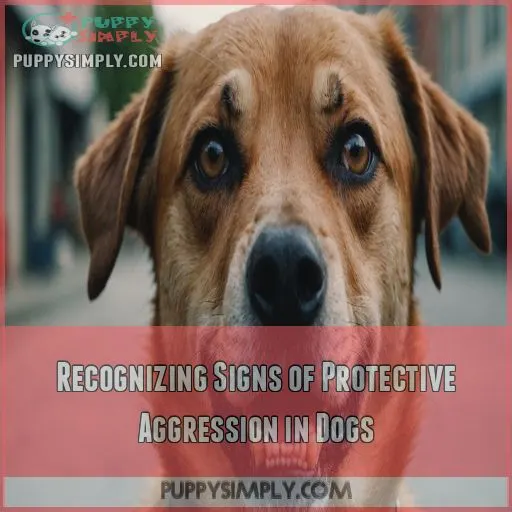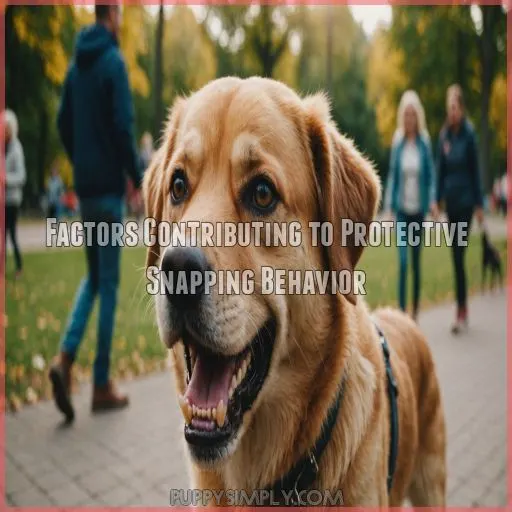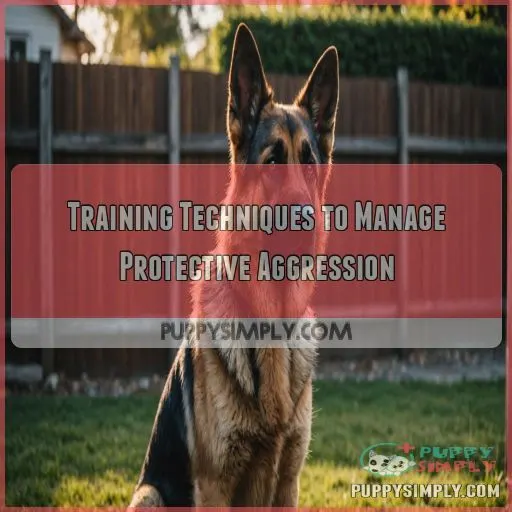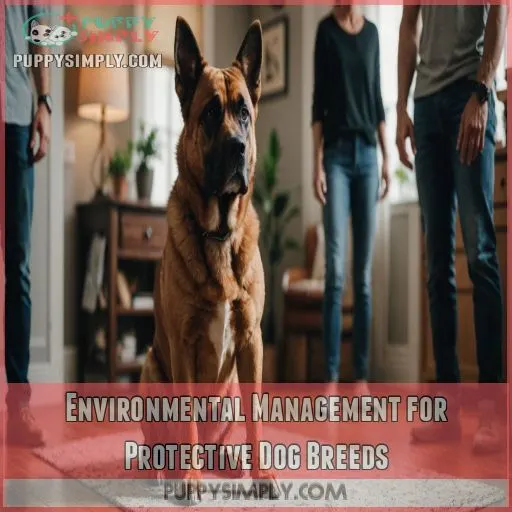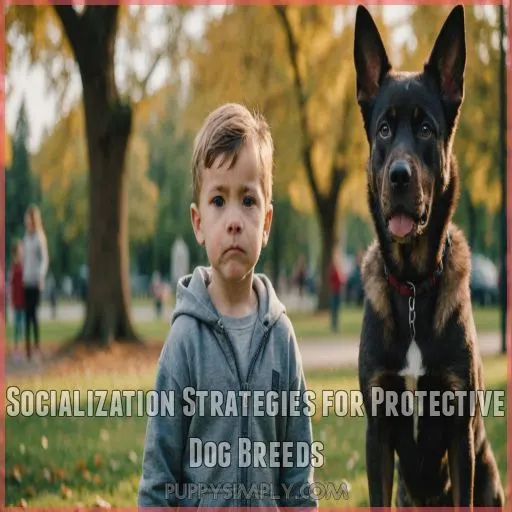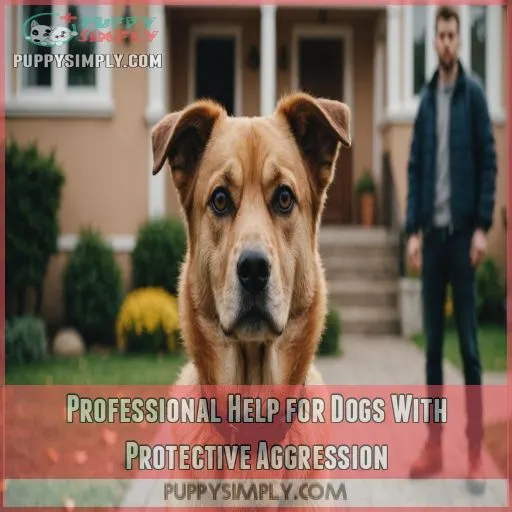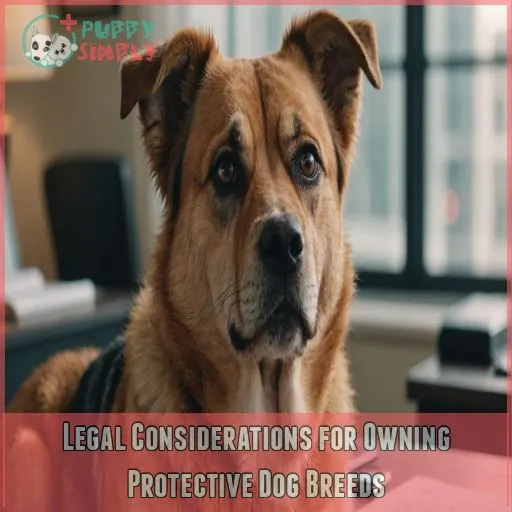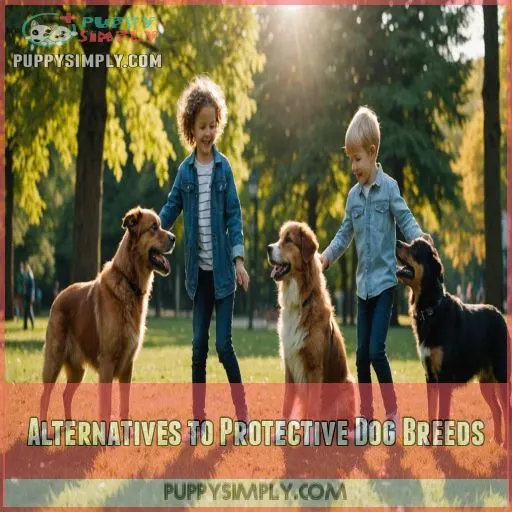This site is supported by our readers. We may earn a commission, at no cost to you, if you purchase through links.
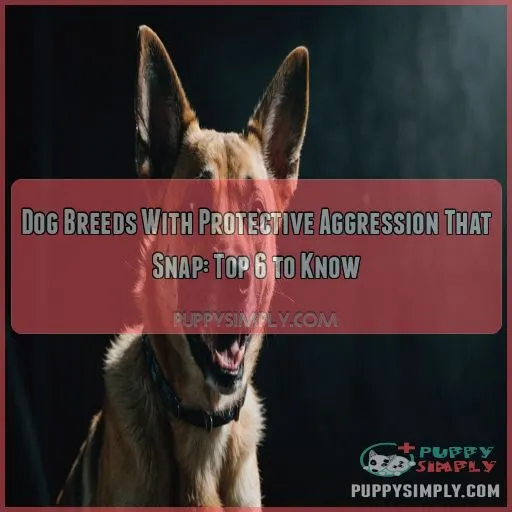 You’re curious about dog breeds with protective aggression that snap? Well, let’s dig into the usual suspects like German Shepherds, Rottweilers, and Doberman Pinschers, known for their loyalty and strength.
You’re curious about dog breeds with protective aggression that snap? Well, let’s dig into the usual suspects like German Shepherds, Rottweilers, and Doberman Pinschers, known for their loyalty and strength.
These breeds can snap when their protective instincts kick in.
This behavior often stems from fear or a deep-rooted urge to guard their turf.
But don’t worry, with the right training and care, you can manage these protective behaviors. Think of it as teaching your dog to choose a calm tea-time conversation over a roaring debate.
Curious about taming their instincts? Stick around for some expert tips and tricks.
Table Of Contents
- Key Takeaways
- Top Dog Breeds Known for Protective Aggression
- Recognizing Signs of Protective Aggression in Dogs
- Factors Contributing to Protective Snapping Behavior
- Training Techniques to Manage Protective Aggression
- Environmental Management for Protective Dog Breeds
- Socialization Strategies for Protective Dog Breeds
- Professional Help for Dogs With Protective Aggression
- Legal Considerations for Owning Protective Dog Breeds
- Alternatives to Protective Dog Breeds
- Frequently Asked Questions (FAQs)
- Conclusion
Key Takeaways
- Know Your Breeds: When looking for a furry protector, breeds like German Shepherds, Rottweilers, and Doberman Pinschers top the list. They’re like Fort Knox on four legs, but without training, they might act out like grumpy mall cops. Early socialization and proper boundaries are crucial to tame these instincts.
- Spot the Signals: Protective aggression isn’t just barking at the mailman. Look for specific signs like growling, snapping, or guarding favorite spots. It’s their way of saying, "Back off, buddy!" Recognizing these behaviors can help you manage them before they become dramas worthy of prime time.
- Training Triumphs: Turn your defensive dynamo into a cool cucumber with the right training. Positive reinforcement, desensitization, and clear routines can make a big difference. Think of it as teaching them to opt for zen over Zorro. It’s not just obedience; it’s peace-making with treats.
- Legal Lowdown: Owning a protective breed isn’t just about love and loyalty. Watch out for breed-specific laws that might feel like hurdles in an agility course. Liability insurance and knowing local leash laws can protect both you and your spirited sidekick from legal snarls.
Top Dog Breeds Known for Protective Aggression
If you’re considering a dog known for its protective nature, it’s important to know which breeds might also have a tendency to snap.
German Shepherds, Rottweilers, Doberman Pinschers, Belgian Malinois, Cane Corso, and American Staffordshire Terriers are at the top of the list, and while they’re loyal and brave, they might act like your home is Fort Knox, especially if they’re not properly trained and socialized. Learn about the different types of Pitbulls!
German Shepherds
german shepherds often demonstrate protective aggression, making them excellent guard dogs.
It’s really important to socialize them early to avoid dog aggression.
With a history as loyal companions and working dogs, their temperament shines with proper training.
Address health concerns proactively and incorporate owner experience into their care.
Otherwise, this breed’s protective nature might unexpectedly snap, leading to dog bites.
Rottweilers
Rottweilers are a powerful breed with a strong protective instinct, as shown by their bite force. Their loyalty runs deeper than the Grand Canyon, but without proper training, you’ve got trouble.
- Mischievous Minds: They need mental challenges.
- Protective Pals: They’re fiercely loyal.
- Health Woes: Watch for hip dysplasia.
- Grooming Habits: Regular brushing keeps that shiny coat.
Embrace their spirited nature with consistent training and affection.
Doberman Pinschers
Doberman Pinschers are known for their imposing stature and fierce protective instincts.
They can make excellent guard dogs, but their strong-willed nature and tendency to be suspicious of strangers require diligent training and socialization from a young age.
With the right guidance, these intelligent pups can become loyal, loving companions who know when to show their protective power.
Belgian Malinois
You might think the Belgian Malinois has a knack for sniffing trouble.
These working dogs need lots of exercise and training to channel their protective instincts.
Watch out for:
- Training Needs: They’re like the energizer bunny.
- Temperament Traits: Sensitive yet intense.
- Pet Care: Invest in pet insurance; their energy could create situations needing coverage.
Manage responsibly!
Cane Corso
Moving onto the Cane Corso, imagine having a guard who’s got your back without breaking a sweat. This breed’s temperament is like a calm warrior. Make sure you have clear training from the start.
Cane Corso Temperament
This breed’s temperament is like a calm warrior. Make sure you have clear training from the start.
Cane Corso Care
| Aspect | Details | Importance |
|---|---|---|
| History | Bred in Italy for protection and hunting | Highlights noble and brave lineage |
| Training | Needs firm leadership and structured guidance | Prevents misunderstanding of protective instincts |
| Health | Regular vet check-ups | Promotes long, healthy companionship |
American Staffordshire Terriers
Leaving the massive Cane Corso behind, say hello to the American Staffordshire Terrier, famously plucky with a heart as big as its muscles.
They’re not born with aggression; their temperament blossoms with love and proper care.
Adopt an Amstaff after ensuring it’s right for you, focusing on socialization and consistent training.
Amstaffs thrive on structure and make loyal companions.
Recognizing Signs of Protective Aggression in Dogs
Recognizing the signs of protective aggression in your dog is really important for keeping everyone safe.
Look out for behaviors like growling, barking, or snapping when strangers approach – these could indicate an underlying issue that needs to be addressed.
Growling and Barking at Strangers
Growling and barking at strangers is a common sign of protective aggression.
Picture a dog barking like it’s auditioning for an opera—mostly, it’s stranger anxiety talking.
Variations exist across breed differences, but owner behavior plays a part too.
Knowing fear triggers and using calming techniques can help your dog pipe down, avoiding barks that echo like unexpected thunder.
Guarding Specific Areas or Objects
Dogs may guard specific areas or objects due to feelings of resource guarding or territoriality.
Spotting this behavior can be important:
- Stationing themselves near beloved toys or spots.
- Growling when you approach their possessions.
- Blocking access to preferred spaces.
- Stiff body language—ever seen someone fiercely protect the remote?
Understanding these signs helps make sure your furry friend feels safe and confident.
Showing Teeth or Snapping When Approached
Seeing your dog bare their teeth or snap when you approach can be a clear sign of protective aggression.
This behavior stems from a place of fear or insecurity, not necessarily malice.
Stay calm, avoid direct eye contact, and slowly back away to defuse the situation.
With proper training and socialization, you can help your pup feel more secure and less inclined to react defensively.
Aggressive Posturing and Body Language
You know your pup’s protective instincts are kicking in when it displays aggressive posturing and body language.
Watch for these cues:
- Stiffened Body: Like a soldier at attention, rigid muscles signal tension.
- Erect Ears: Watchtower mode activated!
- Intense Stare: They’re laser-focused, ready for anything.
- Raised Hackles: A canine way of shouting, "Take heed!"
Understanding these signs helps with threat assessment.
Lunging or Charging at Perceived Threats
When figuring out if a dog is being protective, watch for lunging or charging at perceived threats. It’s an adrenaline-fueled sprint, like a linebacker tackling a dummy.
Trigger identification is key. Knowing whether it’s fear or just well-intentioned guarding can help.
Engaging your dog’s mind with training and understanding the body language cues keeps both you and your dog safe.
Factors Contributing to Protective Snapping Behavior
When your dog snaps in protective aggression, several factors could be contributing to this behavior, and understanding them can help you manage it better.
Lacking proper socialization and the possibility of past traumatic experiences are just a couple of factors that could be contributing to your dog’s protective aggression.
It’s important to play dog detective in uncovering what’s causing your furry friend to go all "guard dog mode.
Lack of Proper Socialization
Lack of proper socialization early in a dog’s life can lead to fearful, anxious behavior and protective aggression down the line.
Puppies need exposure to all kinds of people, animals, and environments to learn that the world isn’t scary.
Without this, they may become overly cautious or defensive when faced with new situations.
Inadequate Training and Boundaries
Sometimes, dogs snap due to inadequate training and boundaries. Imagine teaching a puppy not to hog the sofa. Failing to do so can spell future trouble with protective instincts.
Training and Boundaries are crucial to prevent dogs from snapping.
Here’s how:
- Set consistent rules.
- Reward positive behavior.
- Use clear commands.
- Address bad habits early.
Seek advice from a professional if needed.
Genetic Predisposition to Protective Instincts
You might wonder why some dogs feel like they’re born with a hero complex. Certain breeds have a genetic predisposition to protective instincts, making them more likely to snap as protectors. So, whether you’re reviewing breed-specific legislation or considering genetic testing, it’s essential to understand these traits.
| Factor | Description |
|---|---|
| Ethical Breeding Practices | Prevents unwanted aggressive traits |
| Responsible Ownership | Encourages proper management |
| Early Socialization | Reduces unfamiliarity-induced stress |
Past Traumatic Experiences
A dog’s past trauma can be an emotional rollercoaster, leaving them sniffing for danger even in benign situations.
Fear-induced anxiety may cause protective snapping.
Like a startled cat, a dog’s recovery requires patience and understanding.
Notice changes in behavior and offer calm reassurance.
Hormonal Imbalances or Medical Issues
Hormonal imbalances or underlying medical conditions can also contribute to a dog’s protective snapping behavior.
These may include:
- Thyroid disorders that impact mood and aggression levels.
- Chronic pain or discomfort that makes the dog feel defensive.
- Side effects from certain medications that alter a dog’s temperament.
- Neurological issues affecting impulse control and aggression.
Be sure to consult your veterinarian to rule out any medical causes before addressing the behavioral concerns.
Training Techniques to Manage Protective Aggression
When your protective dog starts snapping, it’s like they’re trying to protect you from imaginary ninjas. Don’t worry, there’s evidence-based training that can help manage this behavior effectively and safely.
Positive Reinforcement Methods
Imagine a dog’s behavior as a block of clay, moldable and full of potential.
Reward-based training can shape behavior effectively.
Clicker training hones focus, while treat-based learning sweetens the deal.
Positive punishment is out like last year’s trends.
Personalize sessions and watch your bond grow stronger.
With patience, protective aggression turns into gentle guidance—a win for everyone involved!
Desensitization and Counter-conditioning
Dog training methods like desensitization and counter-conditioning are a well-known method in managing aggression in cases of interdog aggression.
Think of it as a spa day for fearful dogs—gradually exposing them to triggers while rewarding calm behavior.
This aggression management technique reshapes responses, teaching the dog’s brain to swap panic with popcorn!
Patience is key, turning scary sights into just another Tuesday.
Establishing Clear Leadership and Boundaries
Establishing yourself as the pack leader is key. Use calm, confident body language to show your dog you’re in charge.
Set clear boundaries and be consistent with rules – no exceptions. This earns their respect and helps curb protective aggression.
Teaching Alternative Behaviors to Aggression
Just like the captain steers the ship, guiding your dog with positive reinforcement helps replace aggression with calmness.
When Fido wants to bark at every delivery person, redirect his focus using calm commands.
Desensitization works wonders—gradually exposing him to triggers. Reward his relaxed behavior with praise or treats.
Think of it as replacing growls with wagging tails.
Implementing a Consistent Training Routine
With alternative behaviors established, crafting a consistent training routine is your ace in the hole.
Think of it like baking a cake: consistency, timing, and a sprinkle of rewards make it sweet.
Be patient and set frequent sessions. Dogs thrive on a routine, just like Monday coffee.
Keep it steady, and you’ll have a well-behaved furry friend.
Environmental Management for Protective Dog Breeds
When managing protective dog breeds that might snap, it’s really important to create an environment where they feel safe and secure, just like how you’d want a cozy corner in your home.
Implement containment systems and daily routines that minimize stress, and your protective companion might just thank you by guarding your favorite slippers instead of the front porch.
Creating Safe Spaces for the Dog
By carving out a cozy, dog-friendly nook in your home, you create a safe haven where your pup can retreat and recharge.
A dog-friendly nook can be a personal oasis for your pup, a place to call their own.
Outfit this space with comfy bedding, chew toys, and calming scents to help them feel secure.
Controlling Access to Trigger Areas
Dogs can be funny little creatures, but if Fido’s guarding the mailman like Fort Knox, you might need to rethink his access.
Here’s the plan:
- Trigger Area Identification: Pinpoint areas sparking Fido’s protective instincts.
- Safe Space Design: Create cozy retreats away from hustle and bustle.
- Controlled Entry: Manage when and how Fido explores his world.
For a harmonious home!
Using Barriers and Containment Systems
Just like a good fence makes great neighbors, barriers help keep the peace at home for protective dogs.
Use dog gates or playpens to define safe areas.
Fenced yards provide freedom with boundaries.
Crate training offers cozy retreats.
Leash laws? Think of it as providing peace of mind, like having a superhero on call, not for leaping fences!
Implementing a Structured Daily Routine
A structured daily routine is like a doggie owner’s magic wand, keeping chaos at bay and those protective instincts in check. Try establishing:
- Consistent feeding times to curb food guarding.
- Regular exercise schedules that tire out energetic paws.
- Playtime routines for bonding and relaxation.
Providing Mental and Physical Stimulation
Keeping your pup’s mind and body active is key. Interactive toys, puzzle feeders, and agility courses provide enrichment.
Regular hikes, dog park visits, and playtime let them burn off steam.
A bored, pent-up pooch is more likely to act out. Give them outlets to thrive, and you’ll have a happier, calmer companion.
Socialization Strategies for Protective Dog Breeds
Socializing protective dog breeds can be a fun challenge that prevents them from snapping.
Early exposure to new people, places, and furry friends sets your dog up for success, ensuring lots of friendly tail wagging instead of tense growling.
Early Exposure to Various People and Situations
You’ve got a new pup with protective instincts? Early socialization is your secret weapon. Puppy classes are a godsend, exposing your furry friend to 1. different faces, 2. bustling environments, 3. novel sounds, and even 4. quirky smells.
Desensitization through fun and positive experiences will ease stranger interactions.
Controlled Interactions With Strangers
Stranger anxiety in your protective dog can feel like handling a ticking clock.
Leash training is your magic wand, offering control and predictability.
Create safe spaces for stranger interactions, using greeting rituals to break the ice.
Positive reinforcement acts like applause, encouraging calmness over chaos.
Focus on these steps, like assembling a puzzle, for a harmonious relationship.
Gradual Introduction to New Environments
Gradually introducing your protective pup to new environments is key.
Start small – a quiet park, a friend’s backyard.
Bring tasty treats and let them explore at their own pace.
Avoid overwhelming them with too much sensory input all at once.
Celebrate each step forward with praise and playtime.
Before you know it, they’ll be venturing out like a pro!
Positive Experiences With Other Animals
Creating positive experiences for your dog with other animals can be a game-changer, like introducing peanut butter to jelly. Follow these steps:
- Visit dog parks to master proper etiquette.
- Embrace multi-pet households to promote harmony.
- Volunteer at animal shelters for exposure to interspecies friendships.
Use positive reinforcement training to reward good behavior, building confidence and control.
Ongoing Socialization Throughout the Dog’s Life
As dogs mature, socialization shouldn’t stop—it’s like a lifelong membership to the "stay-cool club."
Keeping interactions positive helps them handle new situations gracefully.
Whether it’s puppy playdates or meeting neighborhood cats, ongoing socialization keeps tails wagging through adolescence, adulthood, and even senior years.
Socialization benefits shine as they adapt smoothly, not snapping at life’s surprises.
Professional Help for Dogs With Protective Aggression
When your protective dog starts snapping, it’s time to call in the pros who tackle doggy behavior like skilled therapists.
You’ll need experts who can help you explore a mix of training, classes, or maybe even a touch of medication, ensuring your pet’s actions don’t become a barking ruckus.
Working With Certified Dog Behaviorists
When dealing with a dog’s protective aggression, working with a certified dog behaviorist can make all the difference.
These experts have the qualifications and experience to get to the root of the issue, crafting a customized training plan that builds trust and teaches your pup alternative, non-aggressive responses.
Their guidance is invaluable – and often more affordable than you’d think.
Consulting Veterinary Behaviorists for Medical Causes
Working with certified dog behaviorists can be eye-opening, but don’t overlook consulting veterinary behaviorists. If your furry friend has a dog bite history or hormonal impacts, medical diagnosis is in order.
- Assess potential hormonal imbalances.
- Identify underlying health issues.
- Discuss behavior modifications.
- Consider safe medications.
- Address medical causes instigating aggression.
Think of it like fixing a crooked painting—sometimes you need an expert eye!
Enrolling in Specialized Aggression Management Classes
Signing up for specialized aggression management classes can be a game-changer.
Imagine your dog channeling its inner zen instead of lunging at the mailman.
Check trainer qualifications, class costs, and length before committing.
Success rates vary, but with effective training methods, improvement happens.
Offering a structured environment, these classes equip dogs and owners with strategies to handle protective aggression gracefully.
Considering Behavior Modification Medication Options
You’ve tried classes, but sometimes Spike still snarls like he’s auditioning for a monster movie.
Medication options could be your next step.
Discuss these with your vet: different types, potential side effects, and costs.
Evaluate the effectiveness and ethical concerns, weighing them carefully.
Implementing Long-term Management Plans
Implementing a long-term management plan is really important for dogs with protective aggression. It’ll take time, effort, and professional support, but you’ve got this! Start by working closely with a certified dog behaviorist to:
- Develop a customized training program
- Identify and manage environmental triggers
- Establish clear boundaries and leadership
- Maintain consistent routines and socialization
Professional support is crucial for developing a long-term management plan for dogs with protective aggression.
With patience and the right plan, you can help your pup feel safe and secure without resorting to snapping or aggression.
Legal Considerations for Owning Protective Dog Breeds
When you’re considering owning a protective dog breed, it’s important to know the legal ropes!
From understanding pesky breed bans to making sure your fence is Fort Knox-worthy, these guidelines help you and your tail-wagging buddy stay out of the doghouse.
Breed-specific Legislation and Restrictions
Breed-specific bans can feel like walking a tightrope.
These laws aim to address public safety concerns but often stir up ethical implications.
They may limit your choice of a furry friend, leading to legal challenges and increased insurance costs.
Understanding these restrictions makes sure you’re prepared, keeping both you and your protective pup on the right side of the law.
Liability Insurance Requirements
When thinking about dog bite lawsuits, liability insurance is a must-have for owners of protective breeds. Here’s the lowdown:
- Policy coverage limits can save your bacon.
- Insurance cost factors depend on the dog’s history and breed.
- A streamlined claims process makes handling incidents easier.
Watch out for breed-specific exclusions in policies.
Feeling protected yet?
Proper Containment and Leash Laws
You’ll want to brush up on your local leash laws – they’re there to keep everyone safe.
Make sure your pup is always on a leash in public, and consider fencing in your yard to give them a secure place to roam.
Dog parks can be great, but keep a close eye on your furry friend.
Responsibility for Dog Bite Incidents
Leash laws are important, but don’t put your hopes in them alone to save the day.
If your dog decides a mailman is looking shady, as the owner, you’re on the hook!
Understanding dog owner liability and breed-specific laws is essential.
Incident reporting and legal recourse might keep you feeling like a shell-shocked mailman yourself!
Potential Consequences of Aggressive Behavior
Handling aggressive behavior is like juggling with a lit torch—it sparks concerns that can scorch you legally when it comes to dog behavior.
Consider these four fiery scenarios:
- Dog bite lawsuits: Potential legal battles and costs.
- Owner liability: Ticklish accountability for incidents.
- Animal control involvement: Might restrict or remove your dog.
- Psychological impact: Stress on families and communities.
Ensure aggressive protectors are safely managed!
Alternatives to Protective Dog Breeds
When you’re seeking alternatives to protective dog breeds, there are several options that offer peace of mind without the potential for aggression.
Modern home security systems that won’t shed on the couch are one option.
Another option is personal protection training that helps you feel secure without a barking escort.
Non-aggressive Guard Dog Options
Instead of protective dog breeds, consider non-aggressive guard dogs that can still provide a sense of security without the risk of snapping.
Breeds like the Bullmastiff, Anatolian Shepherd, and Great Pyrenees offer a calmer, more approachable presence while deterring intruders.
These gentle giants make wonderful family companions too.
Just be ready to provide ample exercise and training.
Home Security Systems and Technology
Who needs a barking protector when you can turn your home into Fort Knox with technology?
Consider smart home security systems.
Options include:
- DIY security systems—easy to install and manage, without monthly fees.
- Security camera types—indoor, outdoor, or even doorbell cameras.
- Home automation—integrate lights and alarms for added layers of safety.
Feel safe, stay connected!
Personal Protection Training for Owners
With security tech in mind, let’s tackle personal protection training.
Sometimes, the best guard isn’t the dog, but you.
Take a self-defense class!
It’s cost-effective, all legal, and boosts your confidence.
Plus, there’s zero risk of shedding on the couch.
Community-based Safety Measures
To promote safety in your community, consider these savvy approaches:
- Neighborhood watch programs help monitor suspicious activity.
- Dog park safety measures ensure a fun, positive environment.
- Advocate for responsible pet ownership through clear communication.
- Support public education campaigns to keep everyone informed.
Choosing Companion Breeds With Lower Aggression Tendencies
Don’t let protective breeds intimidate you – there are plenty of wonderful companion dogs that won’t snap at strangers.
Consider friendly, easygoing breeds like Labradors, Golden Retrievers, or Cavalier King Charles Spaniels.
With early socialization and positive training, these pups make loyal, affectionate family members without the aggressive tendencies.
Explore your options and find the perfect pup for your lifestyle!
Frequently Asked Questions (FAQs)
How can protective aggression affect family dynamics?
Protective aggression in dogs can disrupt family harmony, creating tension and fear.
It’s important to address this behavior through proper training and socialization to make sure everyone’s safety and comfort at home.
With patience and guidance, you can restore peace and trust.
What are common triggers for protective snapping?
Your dog’s snapping can be triggered by perceived threats, resource guarding, or fear of strangers and other animals (Source).
It’s like they’re saying, "Back off, my friend!"
Understand their cues to manage reactions effectively and manage fear of strangers.
Can protective aggression be a genetic trait?
Sure, you might think it’s all nurture, but nature plays a hand too.
Some breeds inherit protective aggression.
It’s like getting an extra sprinkle of spice—great, but it needs careful management through training for safety and understanding.
How does health impact protective aggression behaviors?
Health can make a dog as unpredictable as a loose cannon.
Illness or pain can make a dog feel lousy.
When a dog feels lousy, protective instincts might kick in unexpectedly, leading to sudden, defensive aggression against perceived threats.
What role does diet play in managing aggression?
A proper diet can play a key role in managing your dog’s aggression.
Make sure they’re getting the right balance of nutrients to support calm behavior.
Consult your vet for personalized dietary recommendations that fit your pup’s needs.
Conclusion
Did you know that about 70% of dog owners aren’t aware of their pet’s protective aggression until an incident occurs?
Understanding dog breeds with protective aggression that snap can help you better manage these behaviors.
With the right approach, you’ll transform snapping moments into teachable ones.
Whether you’re picking a doe-eyed puppy or living with a seasoned guardian, prioritize training and socialization.


